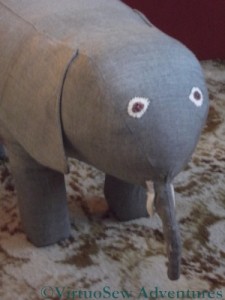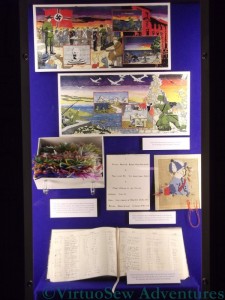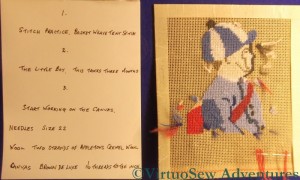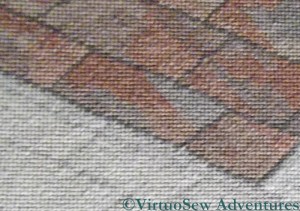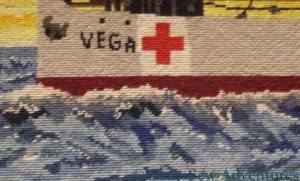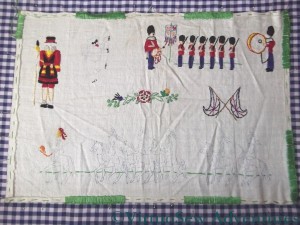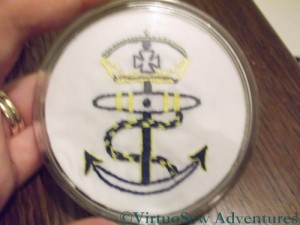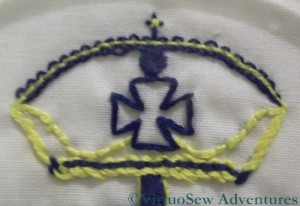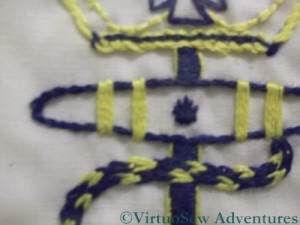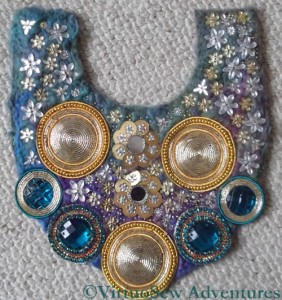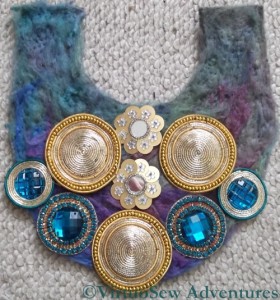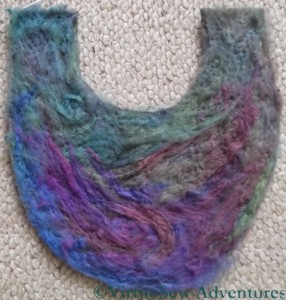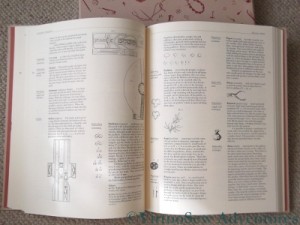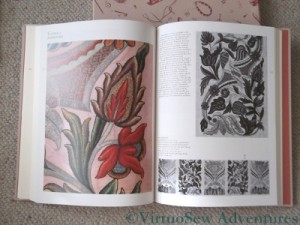Category: General Posts
Reconstructing Cécile
Allow me to introduce Cécile.
Grandmama made her for me when I was about two or three, we think, and I remember her as a constant and beloved part of my childhood. We rediscovered her recently in my parents’ loft, and I thought it would be nice to have her in my own living room, as a footstool and a seat for visiting children. Unfortunately, when I sat back and put my feet up, the stuffing collapsed, and Cécile began to look very sad indeed. So we skinned her (as it were!), washed the skin, and started looking for a suitable replacement for the padding.
In the end, we used a spare cushion pad, and rearranged the stuffing slightly to leave the cover free to be stapled through. I think my grandfather must have made the basic internals – four sections of square wood for legs, screwed firmly into some equally solid half-centimetre thick hardboard.
I have all of Grandmama’s books about needlework and crafts, and there’s nothing like Cécile in any of them, so I think Grandmama must have made her up as she went along. I can’t imagine how she managed to assemble the whole thing unaided, because it took the combined efforts of my mother and myself to put the stockings on, and covering the assembly with the body was even more of an adventure.
But we got there in the end!
I added more stuffing while I was doing the assembly, to make sure that the finished piece would be nicely padded, and swapped the ears around – there was a hole in one side of one of them, which is now the underside.
I’ve also replaced the feet. Grandmama had glued small sections of carpet to the bottom and then stitched around the edge with wool. The carpet was looking distinctly sad and tatty, so I removed it – not without considerable effort! – and replaced it with two layers of grey felt.
Cécile is now reassembled, and just needs some of her finery re-instated. I’ll write about that when I have returned her to her former glory.
Worth A Visit – The Jersey Occupation Tapestry
Regular readers will know that I like large projects for myself; it won’t have been so obvious that I am interested in community or group projects as well. Not just the stitching, but the inspiration, organisation, management and quality control necessary to bring such projects to a successful conclusion.
And make no mistake – quality control can be a serious issue. Often you will hear it suggested that volunteers can’t be expected to do good work, or that, because they are volunteers, anything they produce, however sloppy, should be accepted with enthusiasm and gratitude.
Well, I’m sorry, but I don’t agree. Volunteers should be expected to want to do well, and to practise to make sure that they do.
The volunteers who stitched the Jersey Occupation Tapestry were asked to stitch sample pieces before starting on the real thing. The twelve panels of the Tapestry are worked entirely in Basketweave Tent stitch, which is an easy stitch – but that very simplicity means that there are no textural variations available to hide variations in technique. So all the stitching had to be right. And it was.
The panels were designed by a curator at Jersey Heritage, who then drew out the designs on canvas and marked the thread colours for each element. In the case of seas, skies and such sections, he suggested a range of colours and allowed the stitchers to use their own artistic skills to bring those elements to life. If you look at the photos, I think you’ll agree that his faith in them has been triumphantly justified.
The Jersey Occupation Tapestry Gallery is part of the Maritime Museum in St Helier, and was worked to commemorate the Liberation of the Channel Islands in 1945. Unlike some textile galleries, they don’t mind photographs being taken, although as the panels are displayed behind glass, flashes would be counterproductive as well as unpopular! The display includes some details about Albert Bedane, and a video about the making of the tapestry. Some of the stitchers were children on the island during the Occupation, and some of their memories are included in the designs.
Altogether I had a fascinating time, and can recommend it highly!
Sunny days are on the way!
I was rather flattered to find that Anne wanted to give me an award. As usual, the idea is to link to the giver (which I have), say something about oneself, and then pass the award on to some other bloggers.
Hmm…now, what to say? Ah yes – I’m a true Englishwoman! How can you tell? Well, besides the customary Scottish, Irish and Welsh ancestry, not to mention the Norman French (that was a very long time ago, of course), I’m very proud of being one-eighth Swedish. Only the English – in my experience – are actually proud of being mongrels!
My sidebar blogroll doesn’t reflect the breadth of my reading these days, so here are a few suggestions you won’t find there…
Found in the Archive – a traycloth
My mother and I have been trying to make sense of the various boxes and bags that travelled from my grandparents’ attic to my parents’, and we’ve found all sorts of things.
This traycloth must be something that Grandmama began to work quite late in life, when her eyesight was no longer what it had been, because it’s worked in four strands, and the back would not pass Miss Hunter‘s scrutiny. Judging by the subject matter – maybe she began it in 1977 for the Queen’s Silver Jubilee?
I suspect she intended to alternate the colours of the blanket stitch edging to create the same effect as the coloured blocks of fringing on a ceremonial trumpet’s banner.
I rather like the idea of tackling the parade of guardsmen at the bottom, so I’m planning to add this to my list of projects at some point. It would be the only project of which I would be able to say I had finished what Grandmama started!
I daren’t wash the piece or iron it, because the tracing has already begun to break up in some places. The unstitched motif in the top row is a heraldic lion, and most of his outline has rubbed off. It’s really just as well that I was keen on heraldry as a teenager and still have my books on the subject. I should be able to recreate him without too much trouble.
Blog Award!
I’ve had a blog award passed on to me – thank you, Karen of Stitching Life.
When given this award:
1. Thank the giver and link back to their blog.
2. Reveal your 5 top picks and leave a comment on their blog.
3. Copy and paste the award onto your blog.
4. Have faith that your followers will spread the love too.
My picks:
- Susan of Plays With Needles, for providing thoughtful and thought provoking posts, and truly exquisite embroidery.
- Kathy of The Unbroken Thread, whose careful step-by-step descriptions of technique, and clear joy in creation make her blog a delight to read.
- Megan of Elmsley Rose, who is currently undergoing traumas of blog reorganisation, but whose embroidery posts always make me stop and think, and whose comments here are uniformly supportive and encouraging and frequently insightful as well.
- Alex of Under A Topaz Sky, whose embroidery I find wonderful to behold, although it isn’t a bit like mine.
- Hannah of Embrouderie, whose skills grow with every post as her blog develops.
Thank you, ladies, for hours of delight!
Another ancient piece
About fifteen years ago I was going through one of those periods of penury that we are all subject to, so Christmas presents and birthday presents became rather a challenge – usually solved by making something, with varying degrees of success.
This coaster was made for my grandfather, based on a version of the merchant navy’s Crown And Anchor symbol. It’s worked in ordinary stranded cotton (all I had at the time) and you’ll be surprised what stitches I managed to cram into it!
I don’t imagine that Grandad noticed (he only had one eye – the other was glass – and the working eye was short-sighted), but the top curve of the crown is worked in Pekinese Stitch, worked very small and tight, while the headband is worked with the colours the other way around and slightly larger and looser. The tiny cross on the top is a composite of an ordinary cross stitch worked over a slightly larger upright cross stitch.
The more conventional stitches of course included back stitch, stem stitch, and satin stitch. The cable that is wrapped around the anchor is worked in two rows of Magic Chain Stitch, purely because (if I remember correctly!) I thought it would be fun and had been twitching to try it ever since I had seen it diagrammed. It worked pretty well in the end, as it happens.
It’s not one of my most successful pieces, but it was fun to do, and it came back to me after my grandfather died and now lives beside the spare room bed, ready for glasses of water or cups of morning tea.
An addition to my library
Charles Germain de St Aubin was designer to Louis XV of France, and he wrote a famous work entitled “The Art of the Embroiderer”, which is much referenced among scholars of textiles of the period, but has proven tricky to track down. Not to mention, my grasp of seventeenth century technical French really isn’t up to scratch.
Now, however, I’ve got hold of a recent translation. The Los Angeles County Museum of Art commissioned a translation, and produced the resulting book splendidly, with colour plates of interesting relevant textiles from their collection (annotated by the curator) and a facsimile of the original work, all on good paper and properly bound and presented in a slipcase. I gloat quietly to myself every time I look at it!
The book is of interest to me because he talks of chenille embroidery, and implies that there are two known methods for making a chenille yarn, one of markedly poorer quality than the other. This is very strange, because until some time in the seventies you would have been told that there was only one way to make a chenille, and that the method St Aubin dismisses as being of poor quality. As far as I am aware no one has yet worked out quite what St Aubin meant, or what other technique he was referring to.
Wouldn’t it be wonderful to find out!

